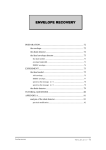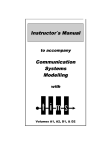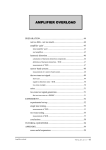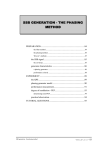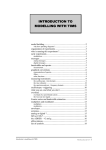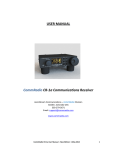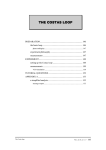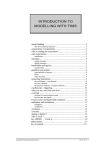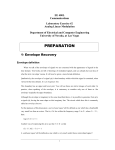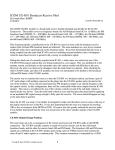Download ARMSTRONG`S PHASE MODULATOR
Transcript
ARMSTRONG'S PHASE MODULATOR PREPARATION............................................................................... 106 FM generation ......................................................................... 106 Armstrong`s modulator ........................................................... 107 theory....................................................................................... 107 phase deviation........................................................................ 108 practical realization of Armstrong`s modulator ...................... 109 EXPERIMENT ................................................................................. 110 patching up .............................................................................. 110 model adjustment .................................................................... 110 Armstrong's phase adjustment................................................. 112 phase adjustment using the envelope......................................................112 phase adjustment using ‘psycho-acoustics’ ............................................112 practical applications............................................................... 113 spectral components ................................................................ 113 TUTORIAL QUESTIONS ............................................................... 116 APPENDIX....................................................................................... 117 Analysis of Armstrong`s signal ............................................... 117 the amplitude limiter ..............................................................................117 Armstrong`s spectrum after amplitude limiting......................................118 Armstrong's phase modulator Vol A2, ch 12, rev 1.1 - 105 ARMSTRONG'S PHASE MODULATOR ACHIEVEMENTS: modelling Armstrong's modulator; quadrature phase adjustment; deviation calibration; introduction to the amplitude limiter. PREREQUISITES: earlier modulation experiments; an understanding of the contents of the Chapter entitled Analysis of the FM spectrum in this Volume. EXTRA MODULES: SPECTRUM UTILITIES; 100 kHz CHANNEL FILTERS (optional). PREPARATION FM generation As its name implies, an FM signal carries its information in its frequency variations. Thus the message must vary the frequency of the carrier. Spectrum space being at a premium, radio communication channels need to be conserved, and users must keep to their allocated slots to avoid mutual interference. There is a conflict with FM - the carrier must be maintained at its designated centre frequency with close tolerance, yet it must also be moved (modulated) by the message. A well know source of FM signals is a voltage controlled oscillator (VCO). These are available cheaply as integrated circuits. It is a simple matter to vary their frequency over a wide frequency range; but their frequency stability is quite unsatisfactory for today`s communication systems. Refer to the experiment entitled Introduction to FM using a VCO in this Volume. Armstrong`s modulation scheme 1 overcomes the problem 2. It does not change the frequency of the source from which the carrier is derived, yet achieves the objective by an indirect method. It forms the subject of this experiment. 1 Armstrong`s system is well described by D.L. Jaffe ‘Armstrong`s Frequency Modulator’, Proc.IRE, Vol.26, No.4, April 1938, pp475-481. 2 but introduces another- it is not capable of wide frequency deviations 106 - A2 Armstrong's phase modulator Armstrong`s modulator Armstrong's modulator is basically a phase modulator; it can be given a frequency modulation characteristic by an integrator inserted between the message source and the modulator. For a single tone message, at one frequency, it is not possible to tell, by what ever measurement, if the integrator is present (so it is an FM signal) or not (a PM signal). Only with a change of message frequency can one then make the decision - by noting the change to the spectral components, for example. theory You are already familiar with amplitude modulation, defined as: AM = E.(1 + m.sinµt).sinωt ...... 1 This expression can be expanded trigonometrically into the sum of two terms: AM = E.sinωt + E.m.sinµt.sinωt ...... 2 In eqn.(2) the two terms involved with 'ω' are in phase. Now this relation can easily be changed so that the two are at 90 degrees, or 'in quadrature'. This is done by changing one of the sinωt terms to cosωt. The signal then becomes what is sometimes called a quadrature modulated signal. It is Armstrong`s signal. Thus: Armstrong`s signal = E.cosωt + E.m.sinµt.sinωt ...... 3 α= 0 α = 90 o Em Em 2 2 Em 2 E E E m= 1 Em 2 Em m= 1 (a) 2 (ω-µ) ω (ω+ µ) (b) Phasor Form Em 2 frequency Amplitude Spectrum Figure 1: DSBSC + carrier The signals described by both eqn. (2) and eqn. (3) are shown in phasor form in Figure 1 (a) and (b) above. The amplitude spectrum is also shown; it is the same for both cases (a) and (b). Each diagram shows the signals for the case m = 1. That is to say, the amplitude of each side frequency component is half that of the carrier. In the phasor diagram the side frequencies are rotating in opposite directions, so their resultant stays in the same direction - co-linear with the carrier for (a), and in phase-quadrature for (b). Both eqn. (2) and eqn. (3) can be modelled by the arrangement of Figure 2 below. Armstrong's phase modulator A2 - 107 DSBSC message (sine wave) g Armstrong`s signal G 100 kHz (sine wave) carrier adjust phase Figure 2: Armstrong`s phase modulator phase deviation Having defined Armstrong`s signal it is now time to examine its potential for producing PM. But first: we have been using the symbol ‘m’ for the ratio of DSBSC to carrier amplitude, because our starting point was an amplitude modulated signal, and ‘m’ has been traditionally the symbol for depth of amplitude modulation.. The amplitude modulation was converted to quadrature modulation. We will acknowledge this in the work to follow by making the change from ‘m’ to ‘∆φ’. Thus: ........ 4 ∆φ = m Analysis shows (see the Appendix to this experiment) that the carrier of Armstrong`s signal is undergoing phase modulation. The peak phase deviation is proportional to the ratio of DSBSC to CARRIER peak amplitudes at the ADDER output; but it is not a linear relationship. The peak phase deviation, ∆φ, is given by: ∆φ = arctan [ DSBSC ] radians CARRIER ...... 5 Remember that the amplitude of the DSBSC is directly proportional to that of the message, so the message amplitude will determine the amount of phase variation. For small arguments, arctan(arg) ≈ arg Thus to minimize distortion at the receiver the ratio of DSBSC to carrier must be kept small. A receiver to demodulate a phase modulated signal is sensitive to these phase deviations. To keep the received signal distortion to acceptable limits the peak phase deviation at Armstrong`s modulator should be restricted to a fraction of a radian, according to distortion requirements as per Figure 3. The analysis of distortion is discussed in the Appendix to this experiment. 108 - A2 Armstrong's phase modulator Figure 3: distortion from Armstrong`s modulator practical realization of Armstrong`s modulator The principle of Armstrong's method of phase modulation, or his frequency modulator (with the added integrator as described earlier), is used in commercial practice. But the circuitry employed to generate this signal is often not as straightforward as the arrangement of Figure 2. It is not always possible to isolate, and so measure separately, the amplitudes of the DSBSC and the CARRIER. So it is not possible to calculate the phase deviation, in such a simple, straight forward manner. Amplitude limiters are also incorporated in the circuitry. These intentionally remove the envelope, which otherwise could be used as a basis for measurement. In these cases other methods must be used to set up and calibrate the phase deviation of the modulator. These include, for example, the use of a calibrated demodulator. There is also the method of 'Bessel zeros'. This is an elegant and exact method, and is examined in the experiment entitled FM and Bessel zeros in this Volume. Armstrong's phase modulator A2 - 109 EXPERIMENT patching up In this experiment you will learn how to set up Armstrong`s modulator for a specified phase deviation, and a unique method of phase adjustment. Armstrong`s generator, in block diagram form in Figure 2, is shown modelled in Figure 4 below. CH1-A ext. trig CH2-A Figure 4: the model for Armstrong`s modulator T1 patch up the model in Figure 4. You will notice it is exactly the same arrangement as was used for modelling AM. The major difference for the present application will be the magnitude of the phase angle α zero degrees for AM, but 900 for Armstrong. T2 choose a message frequency of about 1 kHz from the AUDIO OSCILLATOR. model adjustment T3 check that the oscilloscope has triggered correctly, using the external trigger facility connected to the message source. Set the sweep speed so that it is displaying two or three periods of the message, on CH1-A, at the top of the screen. Now pay attention to the setting up of the modulator. The signal levels into the ADDER are at TIMS ANALOG REFERENCE LEVEL, but their relative magnitudes (and phases) will need to be adjusted at the ADDER output. To do this: 110 - A2 Armstrong's phase modulator T4 rotate both g and G fully anti-clockwise. T5 rotate g clockwise. Watch the trace on CH2-A. A DSBSC will appear. Increase its amplitude to about 3 volts peak-to-peak. Adjust the trace so its peaks just touch grid lines exactly a whole number of centimetres apart. This is for experimental convenience; it will be matched by a similar adjustment below. T6 remove the patching cord from input g of the ADDER T7 rotate G clockwise. The CARRIER will appear as a band across the screen. Increase its amplitude until its peaks touch the same grid lines as did the peaks of the DSBSC (the time base is too slow to give a hint of the fine detail of the CARRIER; in any case, the synchronization is not suitable). T8 replace the patch cord to g of the ADDER. At the ADDER output there is now a DSBSC and a CARRIER, each of exactly the same peak-to-peak amplitude, but of unknown relative phase. Observe the envelope of this signal (CH2-A), and compare its shape with that of the message (CH1-A), also being displayed. T9 vary the phasing with the front panel control on the PHASE SHIFTER until the almost sinusoidal envelope (CH2-A) is of twice the frequency as that of the message (CH1-A). The phase adjustment is complete when alternate envelope peaks are of the same amplitude. As a guide, Figure 5 shows three views of Armstrong’s signal, all with equal amplitudes of DSBSC and carrier, but with different phase errors (ie, errors from the required 900 phase difference between DSBSC and carrier). Armstrong's phase modulator A2 - 111 Figure 5: Armstrong’s signal, with ∆φ = 1, and phase errors of 45 deg (lower), 20 deg,(centre) and zero (upper). Armstrong's phase adjustment An error from quadrature at the transmitter will show up as distortion of the recovered message at the receiver. This will be in ‘addition’ to the inherent distortion introduced by the approximation arctan(arg) ≈ (arg). The ‘addition’ would be anything but linear, and difficult to evaluate, but easy to measure for a particular case. How can the phase of the DSBSC and the added carrier be adjusted to be in exact quadrature ? An analysis of the envelope of Armstrong`s signal is given in the Appendix to this experiment. There it is shown that: 1. when in phase quadrature, the envelope is sinusoidal-like in shape (Figure 5 above) with adjacent peaks of equal amplitude. 2. the envelope waveform is periodic, with the fundamental frequency being twice that of the message from which the DSBSC was derived. Each of these two findings suggests a different method of phase adjustment. phase adjustment using the envelope T10 trim the front panel control of the PHASE SHIFTER until adjacent peaks of the envelope are of equal amplitude. To improve accuracy you can increase the sensitivity of the oscilloscope to display the peaks only. Equating heights of adjacent envelope peaks with the aid of an oscilloscope is an acceptable method of achieving the quadrature condition. For communication purposes the message distortion, as observed at the receiver, due to any such phase error, will be found to be negligible compared with the inherent distortion introduced by an ideal Armstrong modulator. 112 - A2 Armstrong's phase modulator phase adjustment using ‘psycho-acoustics’ There is another fascinating method of phase adjustment, first pointed out to the author by M.O. Felix. The envelope of Armstrong`s signal is recovered, using an envelope detector, and is monitored with a pair of headphones. For the in-phase condition this would be a pure tone at message frequency. As the phase is rotated towards the wanted 90 degrees difference it is very easy to detect, by ear, when the fundamental component disappears (at µ rad/s, and initially of large amplitude), leaving the component at 2µ rad/s, initially small, but now large. This is the quadrature condition. T11 model an envelope detector, using the RECTIFIER in the UTILITIES module, and the 3 kHz LPF in the HEADPHONE AMPLIFIER module. Connect Armstrong`s signal to the input of the envelope detector. Listen to the filter output (the envelope) with headphones. Set the PHASE SHIFTER as far off the quadrature condition as possible, and concentrate your mind on the fundamental. Slowly vary the phase. You will hear the fundamental amplitude reduce to zero, while the second harmonic of the message appears. Notice how sensitive is the point at which the fundamental disappears ! This is the quadrature condition. Note that you have been able to detect the presence of a low (finally zero) amplitude tone in the presence of a much stronger one. This was only possible because the low amplitude term was a sub-harmonic of the higher amplitude term. The opposite is extremely difficult. This is a phenomenon of psycho-acoustics. practical applications Remember: Armstrong`s modulator generates phase, or frequency, modulation, by an indirect method. It does not disturb the frequency stability of the carrier source, as happens in the case of modulators using the direct method - eg, the VCO. But, to keep the distortion to acceptable limits, Armstrong`s modulator is capable of small phase deviations only - see the Appendix to this experiment. This is insufficient for typical communications applications. The deviation can be increased by additional processing, namely by frequency multipliers. The frequency multiplier has been discussed in this Volume entitled Analysis of the FM spectrum. You can learn about them in the experiment entitled FM deviation multiplication (this Volume). Refer also to the Appendix to this experiment. spectral components In later experiments you will be measuring the spectral components of wideband FM signals. In this experiment all we have is Armstrong`s signal, which, after amplitude limiting, has relatively few components of any significance. But they are there, and you can find them. Armstrong's phase modulator A2 - 113 So now you will model the WAVE ANALYSER, which was introduced in the experiment entitled Spectral analysis - the WAVE ANALYSER (this Volume), and look for them. Table A-1 in the appendix to this experiment shows you what to expect. Notice it will be possible to find only three, possibly five, components (including the carrier) with any confidence (the simple WAVE ANALYSER you will be using has its limitations), but confirming their amplitude ratios as predicted is a satisfying exercise. Remember: there are only three components at the output of Armstrong`s modulator (as modelled by you already). To create the FM sidebands Armstrong`s signal must first be: 1. amplitude limited, to produce a narrowband FM signal (NBFM) and then 2. frequency multiplied, to generate a wideband FM signal (WBFM). You will take step (1) in this experiment, and then step (2) in a later experiment. The amplitude limiting is performed by the CLIPPER in the UTILITIES module 3 (with gain set to ‘hard limit’; refer to the TIMS User Manual). Although, for the experiment, there is no need to add a filter following the amplitude limiter (it won`t change the spectral components in the region of 100 kHz), in practice this would be done, and so in the block diagram of Figure 6 below this is shown. If you have a 100 kHz CHANNEL FILTERS module you should use it in this position. amplitude limiter Armstrong`s signal (100kHz carrier) 100kHz BPF NBFM (to WAVE ANALYSER) Figure 6: Armstrong`s NBFM signal T12 set up for equal amplitudes of DSBSC and carrier into the ADDER of the modulator (β = 1), and confirm you have the quadrature condition. A message frequency of about 1 kHz will be convenient for spectral measurements. Although a ratio of DSBSC to carrier of unity will result in significant distortion at the output from a demodulator (refer Figure 3) one can still predict the amplitude spectrum and confirm it by measurement. 3 version V2 or later 114 - A2 Armstrong's phase modulator T13 at the output of your Armstrong modulator add the AMPLITUDE LIMITER (the CLIPPER in the UTILITIES module) and filter (in the 100 kHz CHANNEL FILTERS module) as shown in block diagram form in Figure 6. T14 model a WAVE ANALYSER, and connect it to the filter output. There is no need to calibrate it; you are interested in relative amplitudes. T15 set the phase deviation to zero (by removing the DSBSC from the ADDER of the modulator). Observe and sketch the waveform of the signals into and out of the channel filter. Find the 100 kHz carrier component with the WAVE ANALYSER. This, the unmodulated carrier, is your reference. For convenience adjust the sensitivity of the SPECTRUM UTILITIES module so the meter reads full scale. T16 replace the DSBSC to the ADDER of the modulator. The carrier amplitude should drop to 84% of the previous reading (if you leave the meter switch on HOLD nothing will happen !). This amplitude change is displayed in Table A-1 of the appendix to this experiment. T17 search for the first pair of sidebands. They should be at amplitudes of 38% of the unmodulated carrier. T18 there are further sideband pairs, but they are rather small, and will take care to find. T19 you could repeat the spectral measurements for β = 0.5 (which are also listed in Table A-1). T20 you were advised to look at the signal from the filter when there was no modulation. Do this again. Synchronize to the signal itself, and display ten or twenty periods. Then add the modulation. You will see the right hand end of the now modulated sinewave move in and out (the ‘oscillating spring’ analogy), confirming the presence of frequency modulation (there is no change to the amplitude). Armstrong's phase modulator A2 - 115 TUTORIAL QUESTIONS Q1 by writing eqn.(3) in the general form of a(t).cos[ωt + φ(t)], obtain approximate expressions for both a(t) and φ(t) as functions of ‘m’ (or the equivalent, ∆φ). Q2 can a conventional phase meter be used to set the DSBSC and carrier in quadrature ? Explain. Q3 a 4 volt peak-to-peak DSBSC is added to a 5 volt peak-to-peak carrier, in phase-quadrature. Calculate: a) the peak to peak and the trough-to-trough amplitudes of the resultant signal. b) the phase deviation of the carrier, after amplitude limiting. Q4 suppose the phasing in an Armstrong modulator is adjusted by equating adjacent envelope maxima. Obtain an approximate expression for the phase error α, from the ideal quadrature, as a function of a small error in this amplitude adjustment. Q5 if there is an error in the phasing of an Armstrong modulator, the output could be written as y(t) = E.cosωt + E.cosµt.sin(ωt + α) Obtain an approximate expression for the phase deviation, following amplitude limiting, for small α, the phase error from quadrature. Q6 the phasing in an Armstrong modulator is adjusted by listening for the null of the message in the envelope (the psycho-acoustic method). If during this adjustment the fundamental amplitude is reduced to 40 dB below the amplitude of the second harmonic of the message, what would be the resulting phase error ? 116 - A2 Armstrong's phase modulator APPENDIX Analysis of Armstrong`s signal If we define Armstrong`s signal as: Armstrong`s signal = cosωt + ∆φ.sinµt.sinωt ...... A.1 and then write this in the general form of a narrowband modulated signal we have: ...... A.2 Armstrong`s signal = a(t).cos[ωt + φ(t)] where: a(t) = where (1 + ( ∆φ )2 sin 2 µt ) ...... A.3 φ(t) = arctan (-∆φ.sinµt) ...... A.4 ∆φ = (DSBSC / carrier) ........ A.5. The expressions for both a(t) and φ(t) can be expanded into infinite series. For small values of ∆φ, say (∆φ < 0.5), they approximate to: approx. a(t) = (1 + ( ∆φ )2 ( ∆φ )2 )+( sin 2 µt ) 4 4 approx. φ(t) = ( ∆φ − ( ∆φ)3 ( ∆φ)3 ) cos µt − cos 3µt 4 12 ...... A.6 ...... A.7 Equation A.6 confirms that, to a first approximation, the Armstrong envelope is sinusoidal and of twice the message frequency. There will be higher order even harmonics of the message, but, as you will have observed in the psycho-acoustic test earlier, no component at message frequency. Equation A.7 shows that the phase modulation is proportional to ∆φ, as wanted, but that there is odd harmonic distortion in the received message. The need to keep the distortion to an acceptable value puts an upper limit on the size of ∆φ. Figure 3, shown previously, graphs the expected signal-to-distortion ratio to a better approximation. Remember that eqn.A.7 gives the distortion from an ideal demodulator - it gives no clue as to the spectrum of the Armstrong signal. the amplitude limiter From your work on angle modulated signals you will appreciate that the signal ...... A.8 y(t) = cos[ωt + φ(t)] has the potential for many spectral components. Armstrong's phase modulator A2 - 117 This is an angle modulated signal, which is what is expected from Armstrong`s modulator. But Armstrong`s signal, as defined by eqn.(A.1), has only three components ! We know this since it is the linear sum of a DSBSC (two components) and a carrier (one component). Then where are all the spectral components suggested by eqn.(A.7) ? The signal of the form of eqn.(A.8) is what we want, but we have one of the form of eqn.(A.2). The difference is the multiplying term a(t). We would like a(t) to become a constant. This is the function of the amplitude limiter. It is required to remove envelope variations. The amplitude limiter has been discussed in the Chapter entitled Analysis of the FM spectrum. Armstrong`s spectrum after amplitude limiting Obtaining the spectrum of the amplitude-limited Armstrong signal whilst taking into account the inevitable distortion involves an expansion of eqn.(A.8) with: ...... A.9 φ(t) = arctan(β.cosµt) The phase function can be expanded into an odd harmonic series of µ. ........ A.10 φ(t) = β1.cosµt + β3.cos3µt + β5.cos5µt + ....... This expansion is then substituted in eqn.(A.8). Taking any more than two terms makes the expansion of eqn.(A.8) extremely tedious, and so this means that the approximation is only valid for say the range 0<β<1 Even with two terms in φ(t) the expansion of eqn.(A.8), to obtain the spectrum, is a tiresome exercise. But when finished one has an analytic expression for the spectrum for small β. An alternative is to use a fast Fourier transform and evaluate the spectrum for specific values of β. This has been done, and Table A-1 below lists the amplitude spectrum for β = 0.5 and β = 1 Component amplitude β=0 amplitude β = 0.5 amplitude β=1 carrier ω 1.0 0.945 0.835 ω ±1µ 0.000 0.23 0.381 ω± 2 µ 0.000 0.026 0.072 ω± 3 µ 0.000 0.006 0.031 ω± 4 µ 0.000 0.001 0.009 ω± 5 µ 0.000 0.000 0.004 ω± 6 µ 0.000 0.000 0.001 Table A-1 118 - A2 Armstrong's phase modulator What would happen if this signal, for β = 1, was processed by a frequency multiplier ? The deviation would be increased. What would be the new spectrum ? The analytic derivation of the new spectrum is decidedly non-trivial 4. The easy way to find the answer is to generate it, and then measure it ! Although not specifically suggested, there will be an opportunity for this in the experiment entitled FM deviation multiplication in this Volume. 4 remember, this is Armstrong`s signal, involving the arctan function. Derivation of the spectrum of a pure FM signal, with β = 1, is relatively straight forward (see Analysis of the FM Spectrum).. Armstrong's phase modulator A2 - 119 120 - A2 Armstrong's phase modulator
















